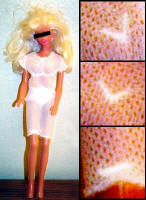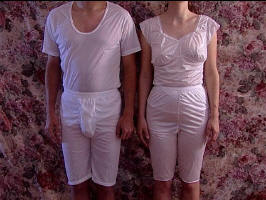|
THE GARMENTS OF THE HOLY PRIESTHOOD |
|
by Bill McKeever Following the washing and anointing ceremonies in the LDS temple ceremony, the patron is then assisted in putting on the "Garment of the Holy Priesthood." Originally this garment closely resembled a pair of long underwear and was only available in a one-piece style. Today, however; some temple Mormons choose to wear a modified two-piece version. Unique to this garment are markings sewn into them which are similar to those used in Freemasonry. Over the right breast is a buttonhole which resembles a "square" (looks like a backward L); over the left breast is a "compass" (resembling a capital V). Sewn into the abdomen and knee area is another marking which looks like an ordinary button-hole. During their pre-endowment instructions, participants are told that if they are true and faithful to the covenants they will make in the ceremony, their "Garment of the Holy Priesthood "will be a shield, and a protection to you against the power of the destroyer until you have finished your work here on earth." Temple Mormons are also told that this garment must be worn throughout their lives and represents the garment given to Adam in the Garden of Eden. Stories of the sacred garment offering protection have long been a part of Mormon folklore. If true, it would seem that wearing their garments would be the soldier's best friend against harm during war. Yet, the LDS Church provides no proof that garment-wearing soldiers all escaped death or injury during war-time conflict. Are we to believe that garment-wearing Mormons are never injured or killed in traffic accidents? Of course the Mormon can always claim that an injury "could have been worse" or that death was allowed because "there work on earth was done." Such answers, however, provide no environment to actually prove if the garments played any role whatsoever. When he appeared in an April 1996 episode of "60 Minutes," San Francisco 49er quarterback Steve Young told interviewer Mike Wallace that he chose not to wear his garments when on the playing field. Some might think that in playing such a dangerous position Mr. Young would best be served by putting them on (especially in light of his injury-plagued 1996 season). Bill Marriott, on the other hand, told Mike Wallace that the garments do in fact offer protection. The owner of the Marriott hotel chain then related a fantastic story how, when he was in a fiery boating accident, his garments protected him from being burned. While the Bible tells the believer to have his "loins girt about with truth" and to put on the "breastplate of righteousness," such metaphorical language never implies Christians are to place their trust in actual physical objects. The idea of protective undergarments falls into the same category as the proverbial rabbit's foot or talisman. It is of pagan origin and has no biblical justification. |

